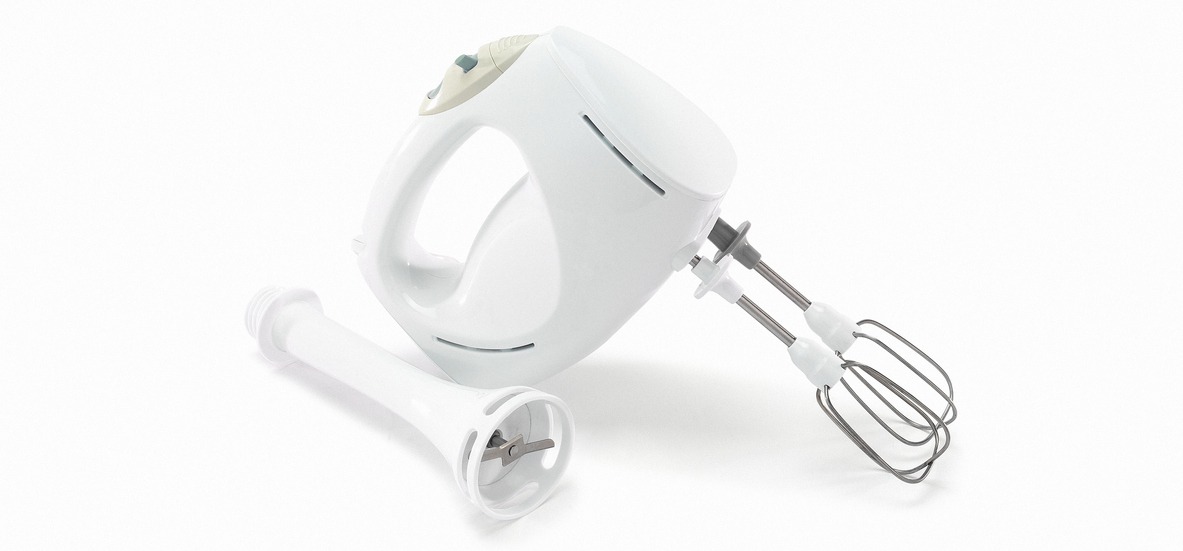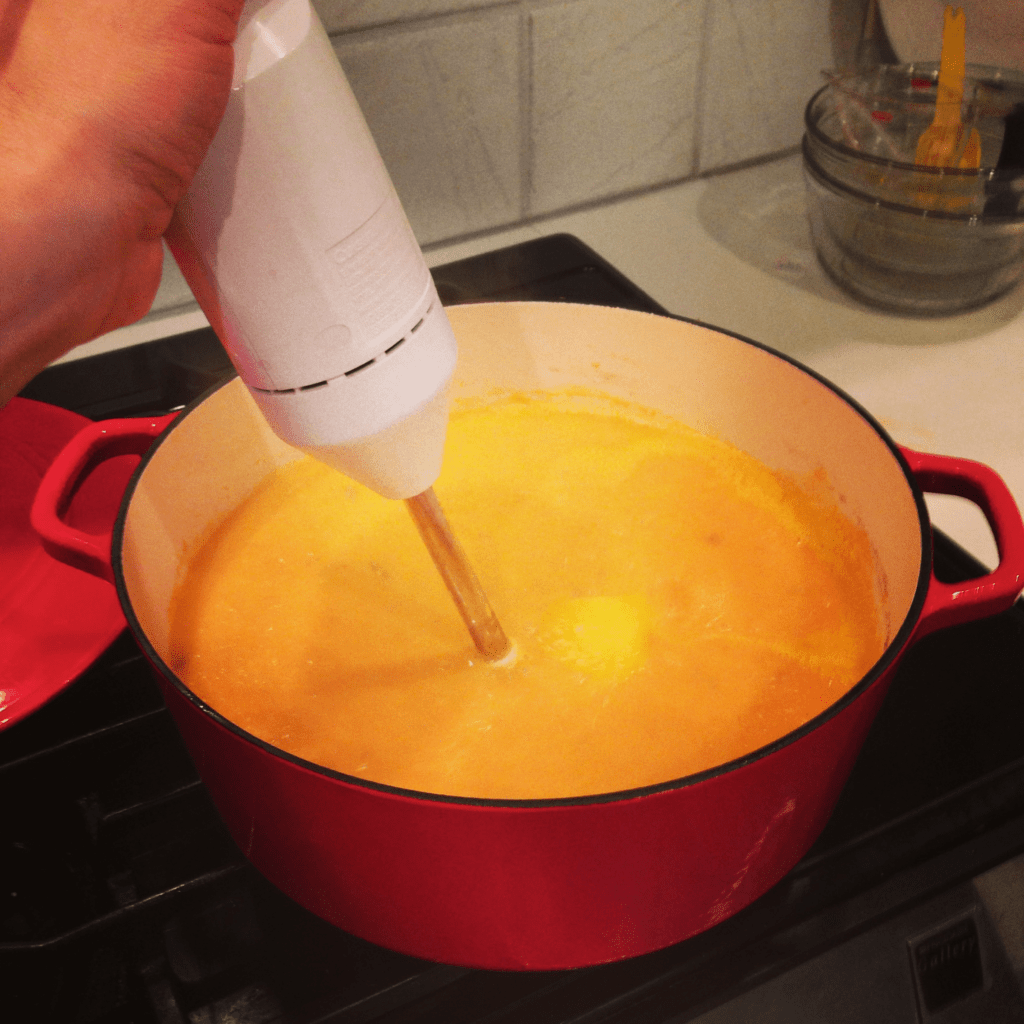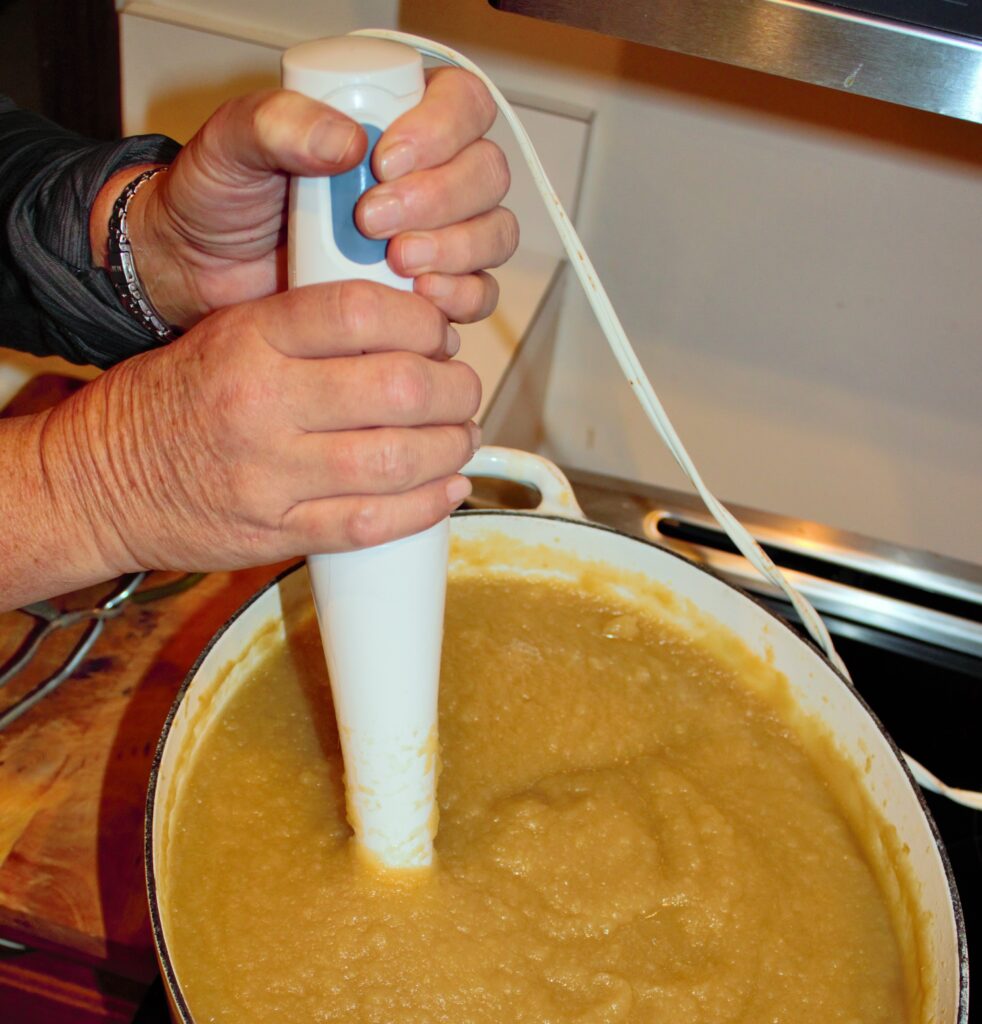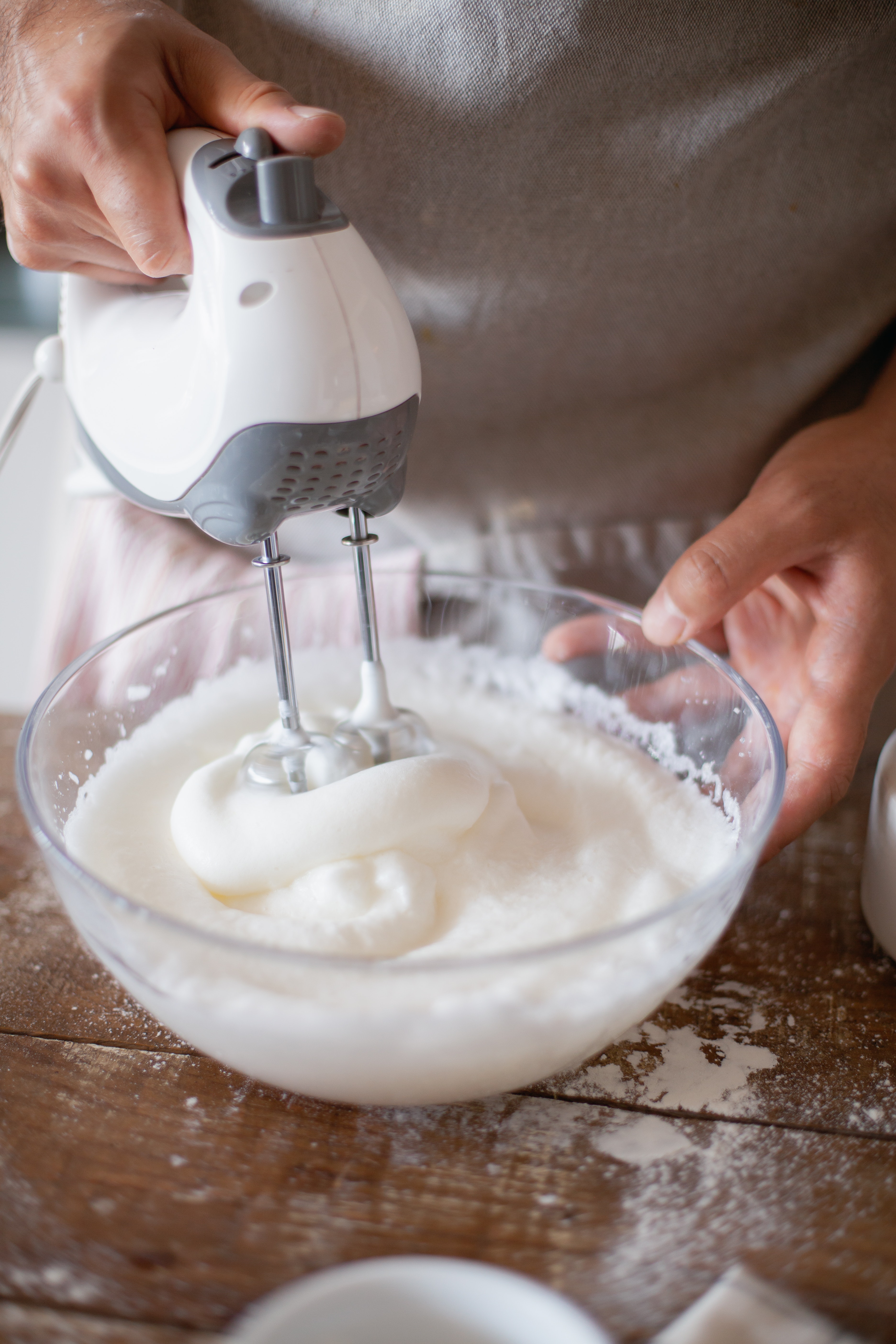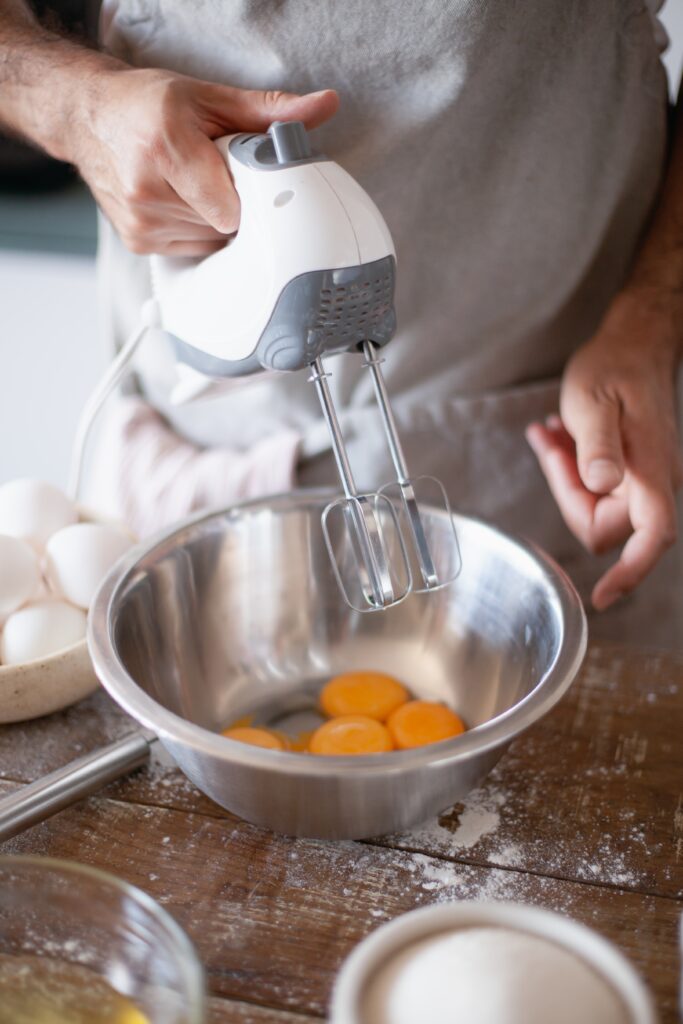A culinary appliance used for blending, pureeing, and mixing foods like mixed berries right in the pot or container where they are being prepared is an immersion blender, commonly referred to as a handheld blender. Immersion blenders are constructed of a motor unit attached to a long, slender shaft with a blade at the end, as opposed to conventional blenders, which have a separate blending container. With this design, blending is easier and more precise, and hot or cold liquids can be blended without running the risk of spills or splatters. Any home cook or professional chef can benefit from the versatility and convenience of immersion blenders, which can be used for everything from blending smoothies and soups to blending sauces and dressings.
A hand mixer is a compact, portable kitchen appliance that is used to whip and combine ingredients. It is made up of a motorized apparatus with two metal beaters or whisks that quickly rotate to combine contents. Hand mixers can be used with any mixing bowl or container, unlike stand mixers, which are designed to be used in one hand and have a set bowl that sits on a countertop. Hand mixers are a popular and cost-effective alternative to bigger and more expensive stand mixers for jobs like whisking eggs, whipping cream, or mixing cake dough. They are an excellent option for home cooks with a small kitchen because they are lightweight, simple to clean, and take up very little storage space.
In order to help users choose the kitchen equipment that is most appropriate for their needs, we will compare an immersion blender with a hand mixer and point out their differences and similarities. Although both tools are used to mix and blend substances, they have unique characteristics and uses that make them more effective for particular jobs. Users may better understand which appliance is most suited for their unique baking and cooking needs by contrasting the design, functionality, and performance of immersion blenders and hand mixers.
What is an Immersion Blender?
An immersion blender is a multifunctional hand blender with several uses in the kitchen. An immersion blender, often known as a hand blender, enables you to prepare ingredients in ways that a regular blender wouldn’t. Electric motor and blending arm are the two major components found in most immersion blenders. We’ll explore what an immersion blender is, what it may be used for, and how to use one properly in this article.
How to use?
1. Connect the blending arm to the housing on the motor body. The blade and power cable are located on the opposite ends of the two pieces, which join in the middle. To make sure the components are joined securely, listen for a click. Hold down the release button on the body as you assemble the two pieces if you are having trouble with this step.
2. Plug in your immersion blender while keeping your hands far from the blade and control buttons. You should place the blade end into the mixing vessel. When combining, a container with high sides will stop spills.
3. Hold down the On button or the speed-specific button. The food combination should be processed with the blade until it reaches the desired consistency. The blender will shut off when you release the button. Note: As long as it’s plugged in, exercise caution at all times!
Advantages And Disadvantages
The following are some advantages of immersion blenders:
Easy to clean – One of the most valued aspects of the immersion blender is definitely this. A comparison of an immersion blender with a countertop blender indicates that the immersion blenders offer a simple cleaning procedure. All you need to do is put the blender’s bottom components in the dishwasher (but only after reading the instruction manual), or you may clean the stick blender by dipping a piece of cloth in liquid detergent water and wiping it down. Cleaning up after mixing is the least favorite part about countertop blenders. The jug must be removed, and the blades must also be cleaned. The particles that got stuck in the blender blades made the operation much more frustrating. You no longer have to deal with the issue of materials adhering to the blades because of immersion blenders.
You can blend the hot ingredients – The stick blender’s capacity to blend hot foods is an important characteristic that attracts users. You may be aware of how challenging it is to blend hot beverages if you have a countertop blender in your kitchen. When attempting to combine soup or coffee in the countertop blender, people frequently wind up hurting or burning their own hands. All things considered, blending any hot item in the countertop blender jar becomes all but impossible. However, there is no need to worry anymore; simply go get the immersion blender. With a stick blender, there is no risk of getting your hands burned because you can insert the blade right into the hot ingredients. So, if you enjoy drinking hot soups or coffee that you’ve mixed yourself, an immersion blender was built specifically for you.
Compact size and lightweight – The ease of transport and travel-friendliness of an immersion blender is other excellent benefit. The stick/immersion blender’s compact size is entirely responsible. The immersion blenders are portable and can be taken anywhere without extra effort, unlike the large countertop blenders. You can include an immersion blender in your luggage, for instance, if you are going on a weekend getaway and you couldn’t imagine not having your morning cup of hot, blended coffee. Having said that, immersion blenders are far lighter than heavy countertop blenders. The users will find it more convenient as an outcome. The immersion blenders don’t take up much room in the kitchen for the same reason. Even better, you can keep an immersion blender in a kitchen drawer or cabinet. Additionally, if you lack any cabinets or drawers, you can hang the stick blender from a wall bracket.
Different types of blades – You might not be aware of the variety of the immersion blenders if you have never used one before. We have every right to claim that these blenders are incredibly adaptable. You won’t believe how many different kinds of blades come with an immersion blender. Put the chopper blades where you wish to chop the vegetables. The puree blades should be used if you want to puree vegetables. Use the stirring blades if you only want to stir your tea or coffee. And use the whipping blade to whisk the soft cream for your cake and whoosh! You can whip your cream in just a few minutes. If the brand does not provide blade attachments, you can buy them separately from the market. You can get all different kinds of attachments there. Today’s immersion blenders also include a jug, a stand or storage case, a wall bracket, occasionally a cover, an extension for blending in large containers, and other accessories. Overall, the invention of the immersion blender was a brilliant one. A stick blender is the best option if you live in a small house.
Let’s now explore the disadvantages of immersion blenders:
- An immersion blender won’t be much use to you if you wish to puree or blend certain hard or stiff components. This is due to the blades’ inability to sufficiently mix the hard materials. However, you can use a countertop blender for these blending needs in an emergency.
- The immersion blenders cannot process huge amounts of ingredients, unlike countertop blenders. A small amount of food can be chopped, crushed, or ground in the immersion blender at once. This is due to the comparatively tiny size of the immersion blender’s blades, which lowers their power.
- You probably won’t like to hear that disadvantage, but immersion blenders shouldn’t be used around young children. And trust us when we say that compared to other kitchen appliances with blades, stick blenders have a terrible reputation for being more dangerous. So, if you’re using an immersion blender, proceed with extreme caution.
- The stability of the immersion blenders has decreased. Naturally, a stick blender that is held in the hand would not be able to provide the same level of stability as a blender that is fixed to the top of a kitchen cabinet. However, choose a stick blender with a pleasant grip if you want the greatest results and perhaps better stability.
Best Uses
- The best immersion blenders for sauces, soups, and smoothies are hand-held models.
- Whipping cream or egg whites is another task for which immersion hand blenders are ideal.
- You may prepare baby food with an immersion blender.Vegetables and other things can be chopped with immersion hand blenders.
- They can also be attached to a stand mixer as a whisk.
What is a Hand Mixer?
A hand mixer is a portable, electric mixer that is useful for blending ingredients in smaller batches and completing short tasks. This adaptable kitchen appliance normally has two detachable beaters and may have several accessories for versatility and convenience. For use and storage, it is small and lightweight
Hand mixers often feature three or more speed settings, and some even have 10 or more, providing you the flexibility you need to mix your favorite recipes effectively. The ability to make light, fluffy frosting in a variety of containers, softly mix nuts into batter, and cream butter and sugar together is made possible by this. Many sell a variety of small, lightweight mixers that are useful for common chores including whipping, mixing, and kneading.
How to use?
1. Attach the beaters – The two detachable beaters that come with most hand mixers must be fitted into the mixer. Until the beaters click into place, align the grooves and gently rotate the beaters.
2. Begin mixing – Press the power switch or button to turn on the hand mixer. By circling the bowl with the beaters to begin, combine the ingredients.
3. Adjust the speed – The majority of hand mixers have many speed options. Depending on the components and the desired texture, adjust the speed.
4. Monitor the mixing process – Keep an eye on the mixture and adjust the beaters’ speed or positioning as necessary.
5. Turn off the mixer – After using it, unplug the hand mixer from the power source and turn it off.
6. Clean the hand mixer – Remove the mixer’s beaters, then wash them in warm, soapy water. Apply a damp towel to the motorized device to clean it.
Advantages and Disadvantages
The following are some advantages of immersion blenders:
- A hand mixer is more portable than a stand mixer, a wet grinder, a mixer grinder, or a grinder because of the way it is made to be small and portable.
- Given that a hand mixer is smaller than most other appliances, one of its significant advantages is that it can be used with just one hand. Yes, the hand mixer’s size makes it simple to operate with just one hand.
- Another important aspect of this device is its energy efficiency; a hand mixer has a compact, effective, and strong motor that is designed to use the least amount of power needed.
- A hand mixer is the greatest option for those who have limited space because of how little room it takes up. While the majority of kitchen gadgets need a lot of room, a hand mixer may be kept in a cupboard.
- The greatest benefit of a hand mixer, in addition to all the advantages listed above, is that it may be used to mix ingredients thoroughly. To mix the food ingredients, a hand mixer is made to be held and moved by the user in any direction.
- Any user of a hand mixer, regardless of the type of food ingredients, can speed up the mixing process by using the rapid mix feature.
- A hand mixer could include a variety of attachments, and each attachment might enable the machine to carry out a particular task.
- A hand mixer, unlike the majority of kitchen appliances, has a design that makes it simple for the user to clean the device.
Let’s now explore the disadvantages of immersion blenders:
- As previously indicated, a hand mixer has a smaller motor, which renders the device useless for mixing huge quantities of food ingredients because the motor cannot function properly under such pressure.
- One of the most prevalent and significant disadvantages of a hand mixer is that the bowl can be moved, which can cause food to fall out and contaminate the area around it as well as cause food to be lost.
- The hand mixer won’t be able to maneuver if the user chooses to mix the extremely thick batter with it.
- Because of the hand mixer’s small and weaker internal motor, efficiency is lower than that of a mixer.
Best Uses
- Anyone who enjoys baking and cooking should invest in a hand mixer.
- You may also use it to make cookie dough for your preferred cookies.
- Because hand mixers require less muscle effort than other devices like stand mixers, they are ideal for people with arthritis or limited mobility.
Think about the following things when purchasing a hand mixer by looking at the graphic below:
Comparing Immersion Blender and Hand Mixer
Immersion blenders and hand mixers may appear to be quite similar kitchen tools at first look. These two kitchen equipment do, however, differ from one another in a number of significant ways.
Design
An immersion blender is made out of a long, wand-like shaft with a variety of attachments. With these add-ons, you can mix, mash, chop, or whip a variety of meals right in the bowl or pot where they’re cooking.
A hand mixer, in contrast, consists of several whisks mounted on a revolving platform. The whisk attachments must be manually inserted into the food being blended or combined.
Performance
An immersion blender outperforms other blenders in terms of performance. With its long shaft, you can combine ingredients without transferring them to another bowl by reaching into tall pots.
Additionally, you can whip cream or chop vegetables in the cooking pot using an immersion blender. This reduces the need for extra bowls and serving utensils and speeds up the cleanup.
Since a hand mixer is made for combining dry ingredients or whipping cream rather than blending sauces or vegetables, it lacks the same adaptability.
Cleaning
The simplicity of cleaning distinguishes these two kitchen equipment from one another significantly. An immersion blender is a highly low-maintenance kitchen appliance because it is simple to wash under running water or put it in the dishwasher.
A hand mixer, on the other hand, usually needs to be disassembled and cleaned manually more thoroughly. The body of the mixer must be wiped off after each use to prevent food buildup, and the beaters must be taken apart and cleaned individually.
An immersion blender is preferable if you’re seeking a kitchen gadget that can quickly blend ingredients or whip cream. A hand mixer is preferable, though, if you need a tool specifically for beating egg whites or mixing dry ingredients.
Which one to use for certain tasks?
Immersion blenders
Blend – Utilize immersion blenders with multiple speeds to mix materials to your preferred texture while smoothly switching between slower and quicker speeds. Or use a hand blender with a preset speed to blend consistently and get the same excellent results.
Puree – Using an immersion blender, make a smooth mixture of ingredients. You may reach into deep pots to blend items from top to bottom by using a longer blending arm. Use the tall, thin container that is included with the variable-speed hand blender when blending a small quantity.
Whip – Certain immersion blenders work with add-ons like a whisk attachment. To quickly achieve stiff peaks for whipped cream or meringues, whisk ingredients like eggs and cream. You may combine oils and other ingredients for your preferred repetitive or spreads like avocado mayonnaise by using a whisk attachment.
Chop – Another accessory that immersion blenders occasionally come with is a chopper. With this attachment, your hand blender becomes a tiny food processor that can be used for tasks like chopping nuts, fresh herbs, veggies, and more.
Hand mixers
Mixing – One of the most popular uses for an electric hand mixer is mixing. Simply described, it entails mixing two or more materials together until they form a single cohesive product. Additionally, mixing introduces air into the batter or dough, which aids in creating baked items with the ideal volume and texture.
Whipping – Using a wire whisk to agitate wet ingredients and incorporate air is known as whipping in baking. Whipping helps you to adjust the volume and lightness of your baked goods by incorporating air into wet components. This technique is frequently used to whip cream and meringue into stiff peaks out of eggs. A hand mixer may assist make sure your final result is light and airy whether you’re baking a layer cake or assembling a delicious asparagus red pepper quiche.
Creaming – The use of an electric beater is expanded upon by the creaming technique. Typically, butter or fat and sugar are combined at a low-medium mixer speed until they are completely mixed, foamy, and pale. When baking cookies or cakes, this is frequently the first step you’ll take because it creates the foundation for all the other ingredients. Creaming also refers to combining heavy cream with other components to soften a solid fat, such as cheese. Make mouthwatering sweet desserts with your hand mixer or savory appetizers like crostini with goat cheese mousse.
Folding – A light, airy component, such as whisked egg whites and sugar into battered or dry ingredients, such as chopped nuts and chocolate or even flour, into a thicker, heavier mixture must be gently included by folding in baking. To avoid overmixing and deflating the air necessary for effective baking, the two types of ingredients should be combined as gently and sparingly as possible. To make a delectable peanut butter chocolate mousse pie, use a hand mixer on low speed to gently fold roasted nuts into cookie dough or melted chocolate into the meringue.
Mashing – To get a light and creamy consistency, components are combined using a crushing and beating motion that includes air. A hand mixer makes it simple to turn potatoes into a hearty side dish, cauliflower into a pleasantly creamy mash, and avocado into a tasty spread for toast. This method can produce twice-baked potatoes, the ultimate comfort food, with the ideal ratio of fluff to crunch.
Kneading – It takes many minutes of constant pushing and pulling to transform a sticky lump of flour, water, yeast, salt, sugar, and occasionally a fat like butter, oil, or eggs into a smooth ball of dough. As a result, the gluten is formed into the elastic-like strands that give bread dough its strength and structure as well as its light and fluffy texture when baked. There are various techniques for kneading yeast dough, and the right consistency can be achieved by utilizing a hand mixer with a dough hook attachment. A mouthwatering treat at every meal is good baked crusty bread with a crisp surface and soft, chewy inside.
Shredding – Traditionally, two forks have been used to take apart boneless, skinless chicken or pork. Let your hand mixer do the work instead. Use a deep mixing basin and the whisks or beaters on your hand mixer. Watch how quickly and easily the meat is pulled apart and prepared for your dish by turning your mixer to low—the lower speed will prevent the meat from splattering out of the bowl.
Conclusion
Both hand mixers and immersion blenders are multipurpose kitchen tools that can be used for blending, mixing, and pureeing. Hand mixers are preferable for tasks requiring whipping or aerating materials, whereas immersion blenders work best for tasks requiring mixing and pureeing in a deep pot or container.
For blending soups, sauces, and other mixes right in the pot or container, immersion blenders are more practical and manageable in terms of ease of use. Hand mixers, on the other hand, are better suited for jobs that call for greater control and accuracy, such as whipping cream or beating egg whites.

